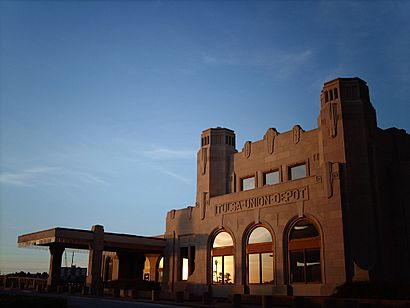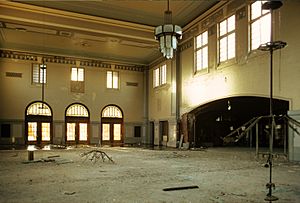Tulsa Union Depot facts for kids
The Tulsa Union Depot (also called the Tulsa Union Station) was once the main train station for Tulsa, Oklahoma. Today, it is an office building. The Oklahoma Jazz Hall of Fame is now located in this historic building.
Contents
A Look Back at the Depot's History
Building a New Station
The Tulsa Union Depot was built in 1931. It was a big project by the Public Works Administration (PWA). The PWA was a government program that created jobs during the Great Depression. Many people saw the Depot as a sign of hope for better times.
The building cost $3.5 million. This money came from a special vote in 1927. The Depot was the first main train station in Tulsa. It brought together smaller stations from different railway companies: the Frisco, Katy, and Santa Fe.
Grand Opening Day
When the Depot opened, over 60,000 people came to celebrate! There were speeches, singing, dancing, and even Indian stomp dancing. The event was heard on the radio too. A brand new train engine was shown off. Also, "Old 94," the engine that brought the first passenger train to Tulsa, was there. The Depot became "Tulsa's important front door." At its busiest, 36 trains arrived and left every day.
Inside the Station
The top floor of the Depot was for passengers. It had separate waiting rooms for different groups of people. In the middle, you could buy tickets and check your bags. People could get to this floor from bridges over the train tracks. An enclosed walkway led to five train tracks below. Stairs and later escalators took people down to the platforms where they boarded trains.
The lower floor was used for mail and packages. Trucks could drive right into this area from First Street.
Why the Depot Closed
Over time, fewer people traveled by train. More people started flying or driving on new highways. Because of this, the Tulsa Union Depot closed in 1967. The last passenger train left the station that year. (Another train company, Santa Fe, kept passenger service to Tulsa until 1971, but they used a different station.)
Famous Trains That Visited Tulsa
Many well-known trains used to stop at the Tulsa Union Depot. These trains connected Tulsa to other big cities across the country. Here are some of them:
| Operators | Named trains | Northern destination | Southern destination | Year begun | Year discontinued |
|---|---|---|---|---|---|
| Frisco Railway | Black Gold | terminus | Oklahoma City | 1938 | 1959 |
| Frisco Railway | Firefly | Kansas City | Oklahoma City | 1939 | 1960 |
| Frisco Railway | Meteor | St. Louis | Lawton | 1902 | 1964 |
| M-K-T | Bluebonnet | terminus | Galveston via Dallas and Houston | 1928 | 1958 |
| M-K-T | Katy Flyer | terminus | Galveston via Dallas and Houston | 1896 1900 |
1959 |
| M-K-T | Texas Special | St. Louis | San Antonio via Dallas | 1915 | 1965 |
| Santa Fe | Tulsan | Chicago | terminus | 1930 | 1971 |
The Depot's New Life
Bringing the Building Back to Life
In 1980, a company called Williams Companies bought the old Depot. They hired the same construction company that built it in 1931 to restore it. In 1983, after the work was done, the Williams Companies used the building for their own offices.
Home of the Jazz Hall of Fame
In 2004, Tulsa County bought the building. They spent money to fix it up even more. The building was then given to a group called the Tulsa County Industrial Authority. This group made a special agreement with the Oklahoma Jazz Hall of Fame. The Jazz Hall of Fame could use the building for 99 years for only $1!
The Jazz Hall of Fame started using the building in 2007. They officially took control in 2009. They now call the building the Jazz Depot. There have been some disagreements about paying for the building's costs, but the Jazz Hall continues its work there.
For a while, there was talk about bringing passenger trains back to Tulsa. People wondered if the Jazz Depot could be used as a train station again. However, those plans did not happen.
In late 2020, there were some legal issues about the Jazz Hall's lease. The Jazz Hall of Fame later filed for bankruptcy, which put a pause on these issues.
The Depot's Cool Design
The Tulsa Union Depot was built in the Art Deco style. This was a very popular design style in the 1930s, especially in Tulsa. The architect was R.C. Stephens. The building has cool design elements like zigzags (chevrons), winged wheels, and sunburst shapes. These machine-like designs were very fashionable at the time.
| Preceding station | Atchison, Topeka and Santa Fe Railway | Following station | ||
|---|---|---|---|---|
| Terminus | Tulsa – Kansas City | Mohawk
toward Kansas City, Missouri
|
||



